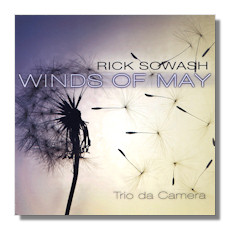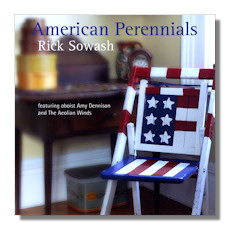
The Internet's Premier Classical Music Source
Related Links
- Sowash Reviews
- Latest Reviews
- More Reviews
-
By Composer
-
Collections
DVD & Blu-ray
Books
Concert Reviews
Articles/Interviews
Software
Audio
Search Amazon
Recommended Links
Site News
 CD Review
CD Review
Rick Sowash

Music for Clarinet Trio
- Trio #5 "In the Classical Style"
- Trio #7 "The Philosopher Visits a Country Fair"
- Trio #8 "Two Self-Portraits"
- Trio #10 "Winds of May"
Trio da Camera
Rick Sowash Publishing RSP-7 57:37


American Perennials
- Mt. Airy Wedding Suite
- Spring Fever Suite
- 3 Piquant Pieces
- Picket Fence
- 3 American Perennials
Amy Dennison, oboe
Marion Peraza de Webb, violin
Ellen Shertzer, cello
Theresa Villani, cello
Katharine Cinelli, viola
Naoko Tanaka, piano
The Aeolian Winds
Rick Sowash Publishing RSP-8 57:37
Summary for the Busy Executive: A lot with a little.
A composer who hails from my home state of Ohio, Rick Sowash has lived, in his own words, "by his wits," which of course composers must do these days unless they teach, inherit money, or hit the Powerball or its equivalent. Writing concert music doesn't pay the bills, even if people like what they hear, if we assume they get a good chance to hear it. Most composers write, unfortunately, mainly because they can't help themselves and live for the performances they can scare up.
I like quite a bit of Sowash's music. I hear in it the plain-speaking Midwestern wit and elegist, whose greatest exemplar is Abraham Lincoln. Sowash's clarity seems to me harder to pull off than many an obscurantist's murk in that he has no notes to hide behind or to disguise a lack of basic invention. Fortunately, invention is one of Sowash's strong suits. Also, a simple face may indicate lack of character. The surface of Sowash's music may pose few problems, but usually you hear something solid beneath.
These CDs concentrate on chamber works – the first a collection of four clarinet trios, the second a potpourri of mixed ensembles, nothing larger than a quintet. Sowash has larger works, but like many composers, he issues these CDs on his own dime. Chamber music costs less to produce than orchestral, for obvious reasons. Within these limitations, however, Sowash produces a great variety of music.
For example, the clarinet trios – a combination, incidentally, which produces a beautiful sound – while sharing an idiom, differ from one another in mood and intent. The mordant Trio #7, "The Philosopher Visits a Country Fair," relates the Isaak Walton anecdote of the Cynic Diogenes of Sinope (he who wandered with a lantern in search of an honest man) visiting a fair and exclaiming, "Lord, how many things there are in this world of which Diogenes hath no need." The piece has three parts: the first depicts a quaint country fair; the second, longer section, described by the composer as "hymn-like," represents the philosopher; the third brings back the music of the fair, initially in fugato, alternating with and then played against the hymn. The fair music has the last word.
Trio #10, "Winds of May," has four movements: "Morning – Allegro," "Deep Forest – Adagio" (with an introduction and coda for solo cello), "Wildflowers – Allegretto," and "Sunset – Adagio." The work is open-hearted and follows the poetic implications of its titles. A lovely score, it put me in mind of French composers like Ibert and Françaix, just to give you some idea of its flavor.
Sowash creates two movements for Trio #8, "Two Self-Portraits": "Self-Portrait as a Fool" and "Self-Portrait as Sage." The first, a canon sandwiching a straightforward middle, has Eastern European overtones and a humor not unlike the scherzo in Mahler's First (although on a much smaller scale) as it bumbles along, while the second is full of sadness, momentary triumph, and ultimate regret.
Unfortunately, I don't care for the Trio #5, "In the Classical Style," for its classical gestures seem hackneyed to me. Sowash himself doesn't seem to attach much importance to it (although enough to write and record it). He describes it more or less as a lark. This is another hazard of Sowash's idiom. If you don't like the theme, you probably won't care for the piece, no matter how ingenious the treatment. I except the second movement, variations of Thomsonian simplicity and fervor.
Sowash wrote the Mt. Airy Wedding Suite (oboe, violin, cello) for a friend's wedding. The gigue-ish "Prelude" takes off from those arpeggiated Bach preludes, like the very first in The Well-Tempered Clavier, with a call-and-response setup between the strings and a longer melody in the oboe. The following movement, "Romance," doesn't come off. For me, it has too many holes in the texture and too little variety in the ensemble, although I do like the tune. "Fugue," on the other hand, solves all those problems. The independence of the parts not only propels the movement but hides the thinness of the ensemble. The suite ends with a "Rondo," using a main theme with a couple of touches so goofy that the piece approaches PDQ Bach territory. The episodes, on the other hand, are earnestly romantic, appropriate for a wedding.
Spring Fever Suite employs an even thinner ensemble – two cellos. It opens with another lively gigue ("Peasant Dance") and then moves to a "Gershwinesque Love Song." Now, I happen to know a lot of Gershwin and find nothing especially reminiscent in Sowash, so the question becomes how fares the movement itself. Pretty well, it turns out – long lines, which a stronger sense of forward motion from the (in this case) single player on a dub would have helped. As it is, the cellist (in a duo via overdubbing) sounds as if she slogs through a bog of taffy. Things improve in the next movement (also slow), "Ferns Unfolding," but the music could use even more line. Scherzo, of course, means "joke." "Baseball Scherzo" starts out soberly, until you realize that it hints at "Take Me Out to the Ball Game" ("Buy me some peanuts and Cracker Jack" in minor mode) while the trio perhaps gives us a cryptic "I don't care if I ever get back" and the ending sings "One, two, three strikes – You're out!" The musical humor hangs a bit on the dry side. If Sowash hadn't given me the title, the jokes would have gone right by me. I think it especially nifty that he begins with the song's second strain and, as far as I can tell, never quotes the opening line. "Daffodils" breathe serenely, since, like the lily, they neither toil nor spin – my favorite movement of the suite. The concluding "Barn Dance" begins slowly before dipping a toe into Aaron Copland Rodeo "Hoedown" territory.
According to Sowash, of the 3 Piquant Pieces (oboe plus string trio), "the first is a wistful little waltz," the second "an expression of religious feeling," and the third "a delightful foray into eastern European music." The waltz leans more to French valse than to its Viennese or Tchaikovskian counterpart. Although the second piece may stem from Copland's hymn-like moments, its harmonic language is both beautifully unpredictable and Sowash's own. I feel that the vivacious third movement rubs up against klezmer, but my listening history primes me for that association.
Sowash gives a history and a composer's general overview of Picket Fence (violin, oboe, piano), the latter of which I don't follow at all. Or at least I don't hear the structural elements he identifies. However, I do hear the general effect – the long, outward impulse of singing over a quasi-ostinato in the piano. This score's one movement runs the longest by far of any on the program, and to keep up such a span, without standard motivic development or the joins between the sections showing impresses me greatly. The music sounds seamless. Another beauty.
3 American Perennials, for woodwind quintet, begins with a sprightly barn dance which occasionally moves through an Ivesian farrago back to simplicity again. A "Sea Chanty" follows, which hints at the loneliness of a sailor's life, like "Hilo" and "Stormalong." Open fifths and quartal harmony emphasize both the hardness and the stoicism of such a life. The work ends with a high-steppin' rag. I recommend the entire score to woodwind quintets looking for something fun, poetic, and new.
Most of the players serve the composer very well, with the exception of the cellist who plays (both parts) of Spring Fever. Notwithstanding the feat of playing against a recording of yourself (harder than you might imagine), I believe it would have been better to use two live cellists for true give-and-take. Indeed, only one instance of playing against a pre-recorded track of complex music has satisfied me: Bill Evans's Conversations with Myself. Nevertheless, I'm bringing up niggles. None of this should deter anyone from this highly attractive music Both CDs are available from Rick Sowash's website.
Copyright © 2014, Steve Schwartz


















